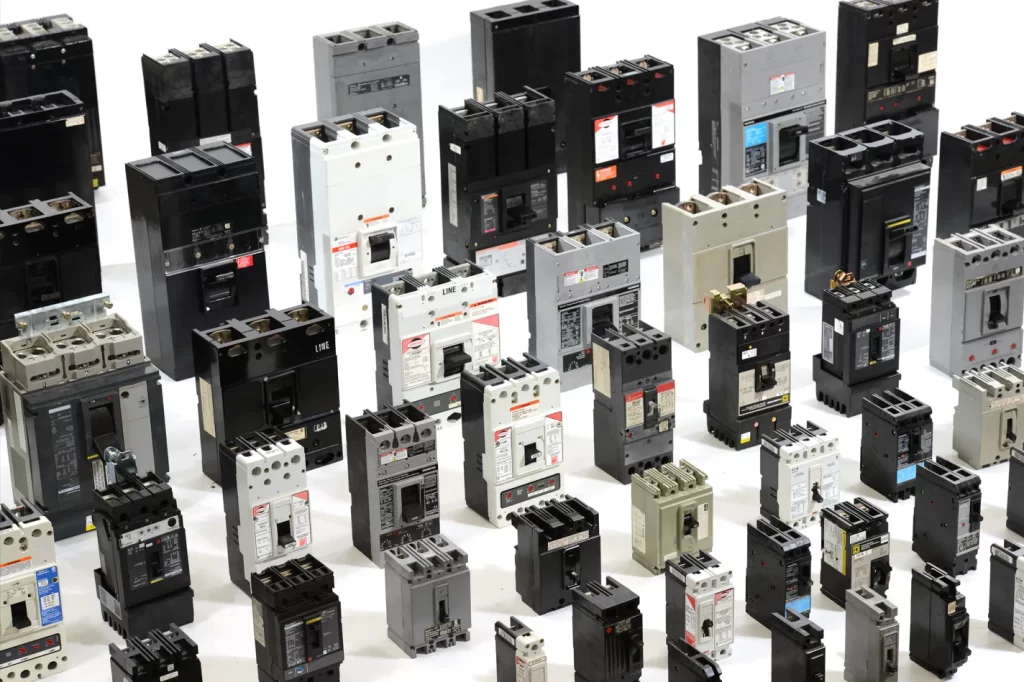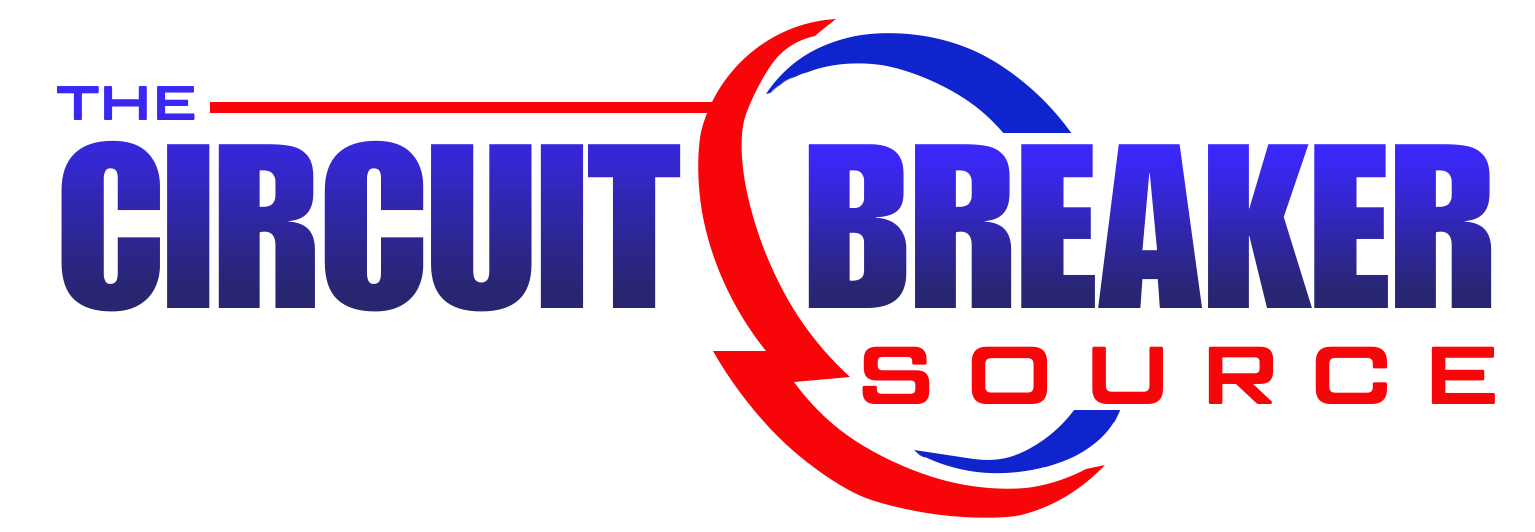
Every home, business, and industrial facility relies on electrical systems to ensure power runs smoothly and safely. The electrical equipment supporting this flow ranges from the small circuit breakers in a service panel to the large transformers and switchgear. These equipment serve as the backbone of today’s power distribution.
At The Circuit Breaker Source, we partner with homeowners and businesses nationwide to provide tested, reliable electrical equipment that meets today’s safety and performance standards.
This guide covers what electrical equipment is, the different types used in various settings, how they work together, and key factors to keep in mind when purchasing, maintaining, or replacing them.
What Is Electrical Equipment
Electrical equipment includes any device, component, or system used to generate, transmit, distribute, or consume electricity. This ranges from everyday outlets and lighting fixtures to large industrial installations.
Common examples include:
Switchgear and circuit breakers are used to control and isolate electrical circuits.
- Transformers are used to change or adjust voltage levels.
- Panels and load centers are used to distribute electrical power throughout a building or facility.
- Cables, connectors, and relays are used to transfer electricity and monitor its flow.
- Protective devices like fuses, GFCIs, and surge suppressors help safeguard electrical systems.
- Every component serves a specific purpose, and together they make sure electricity reaches its destination safely.
Every component plays a specific role, and together they ensure that electricity is safely delivered exactly where it’s needed.
Why Electrical Equipment Matters
Modern life relies on electricity, and its safe use depends on the design and condition of the equipment that carries it. Choosing and maintaining the right equipment helps prevent overloads, fires, and power outages. It also boosts efficiency, helping extend the lifespan of connected systems like HVAC units, computers, and industrial machinery.
Reliable electrical equipment:
- It protects systems against faults and short circuits.
- It minimizes downtime caused by power outages.
- It helps ensure compliance with national and local electrical codes.
- It enhances overall energy efficiency and improves operational safety.
In homes, this translates to reliable electricity and reduced fire risk. In industrial settings, it ensures uninterrupted production and safeguards valuable equipment.
Main Categories of Electrical Equipment
Electrical equipment can be classified into different categories depending on its function and voltage level.
1. Power Generation Equipment
This category includes generators, alternators, and turbines that produce electricity. While most homes depend on the utility grid, many businesses and facilities use backup generators or renewable systems like solar inverters.
2. Transmission and Distribution Equipment
After electricity is generated, it needs to be transmitted and distributed safely. This includes transformers, switchgear, transmission lines, and substations, all of which manage voltage and control how power is delivered to various locations.
3. Control and Protection Equipment
These devices help maintain system stability and prevent damage. Circuit breakers, protective relays, and isolators automatically cut off electricity during faults or overloads.
4. Utilization Equipment
This category includes the devices that consume electricity, such as lighting systems, motors, appliances, and electronic equipment.
5. Monitoring and Measurement Equipment
Meters, sensors, and control panels monitor energy usage and provide data to support maintenance and improve efficiency.
How Electrical Equipment Works Together
In every building or facility, electrical equipment works together as an interconnected system.
- Electricity enters the building from either a utility source or a generator.
- Switchgear and panels manage and direct electricity to the appropriate circuits.
- Breakers and fuses safeguard the system against overloads and electrical faults.
- Transformers modify voltage levels as needed.
- Outlets, motors, and fixtures draw the electricity required for their operation.
Each stage relies on the others, and a problem in one component, like a faulty breaker or damaged cable, can impact the entire system. That’s why proper design, installation, and testing by professionals are crucial for safety and reliability.
Residential vs. Industrial Electrical Equipment
Residential electrical equipment prioritizes safety and ease of use. Panels usually operate at 120/240 volts and often include GFCI and AFCI protection to help prevent shocks and reduce fire risks.
Industrial and commercial electrical equipment runs at higher voltages, often over 480 volts, and is designed to handle heavier loads. This includes large switchgear, transformers, motor control centers, and power distribution units.
Industrial systems also demand regular maintenance and strict compliance with OSHA and NEC regulations.
How Electrical Equipment Is Tested and Certified
At The Circuit Breaker Source, all used or refurbished equipment is thoroughly tested before being sold. This testing confirms that each piece operates within its rated limits and meets UL, ANSI, and IEEE standards.
Typical tests include:
- Insulation resistance testing is performed to detect leakage or insulation breakdown.
- Trip and timing tests are performed on circuit breakers to ensure they operate correctly and respond within the required time.
- Contact resistance tests are conducted on switches and connectors to ensure proper conductivity and reliable performance.
- Mechanical inspections are carried out to check for corrosion, wear, or other physical damage.
Certification gives buyers confidence that the equipment is safe, compliant, and ready for use.
Buying or Selling Used Electrical Equipment
Electrical equipment can last for many years. With proper maintenance, panels, breakers, and switchgear can operate safely for decades, which has created a robust market for used and refurbished equipment.
At The Circuit Breaker Source, we assist contractors, facility managers, and homeowners looking to buy or sell tested electrical components.
For buyers, used equipment provides:
- Offers a lower cost compared to new equipment.
- Provides immediate availability for urgent replacements.
- Works with older systems that manufacturers no longer support.
For sellers, it’s a chance to recoup value from surplus or decommissioned equipment. We buy and test used panels, switchgear, breakers, and related components from across the country, making sure they can be safely reused.
Maintenance and Safety Considerations
Regular maintenance is the key to prolonging the life of electrical equipment. Inspections should look for signs of heat damage, corrosion, loose connections, and dust accumulation.
Safety practices include:
- Always de-energize circuits before performing maintenance.
- Adhere to proper lockout and tagout procedures.
- Promptly replace any damaged insulation or wiring.
- Use only components that are rated for the appropriate voltage and amperage.
- Make sure equipment enclosures stay dry and fully intact.
Hiring licensed electricians and using certified components significantly lowers the risk of electrical accidents.
FAQs
How long does electrical equipment last?
Most electrical equipment has a lifespan of 20 to 40 years, depending on usage and environmental conditions. Regular testing and maintenance can help extend its service life.
Can used electrical equipment be as safe as new?
Yes. When properly tested and certified to meet UL and ANSI standards, used electrical equipment can perform just as safely as new units.
What are the most common causes of electrical equipment failure?
Moisture, heat, mechanical wear, and overloading are the main causes. Regular preventive maintenance helps identify and address problems before they lead to failure.
What standards apply to electrical equipment in the U.S.?
Important standards include the National Electrical Code (NEC), UL certifications, and ANSI/IEEE testing guidelines.
How do I know what equipment my facility needs?
Your requirements depend on load capacity, system voltage, and facility layout. A licensed electrician or our technical team can assess your setup and recommend the appropriate equipment.
Final Thoughts
Electrical equipment forms the backbone of modern life, enabling homes, offices, and industries to function safely and efficiently. Every breaker, panel, and wire plays a vital role in protecting people and property from electrical hazards.
At The Circuit Breaker Source, we ensure that all equipment we supply or purchase meets the highest safety and performance standards. Whether you’re updating old panels, expanding an industrial system, or selling used components, our mission is to help you maintain reliable, compliant power systems.
Reliable electricity starts with reliable equipment, and that’s exactly what we deliver every day.
